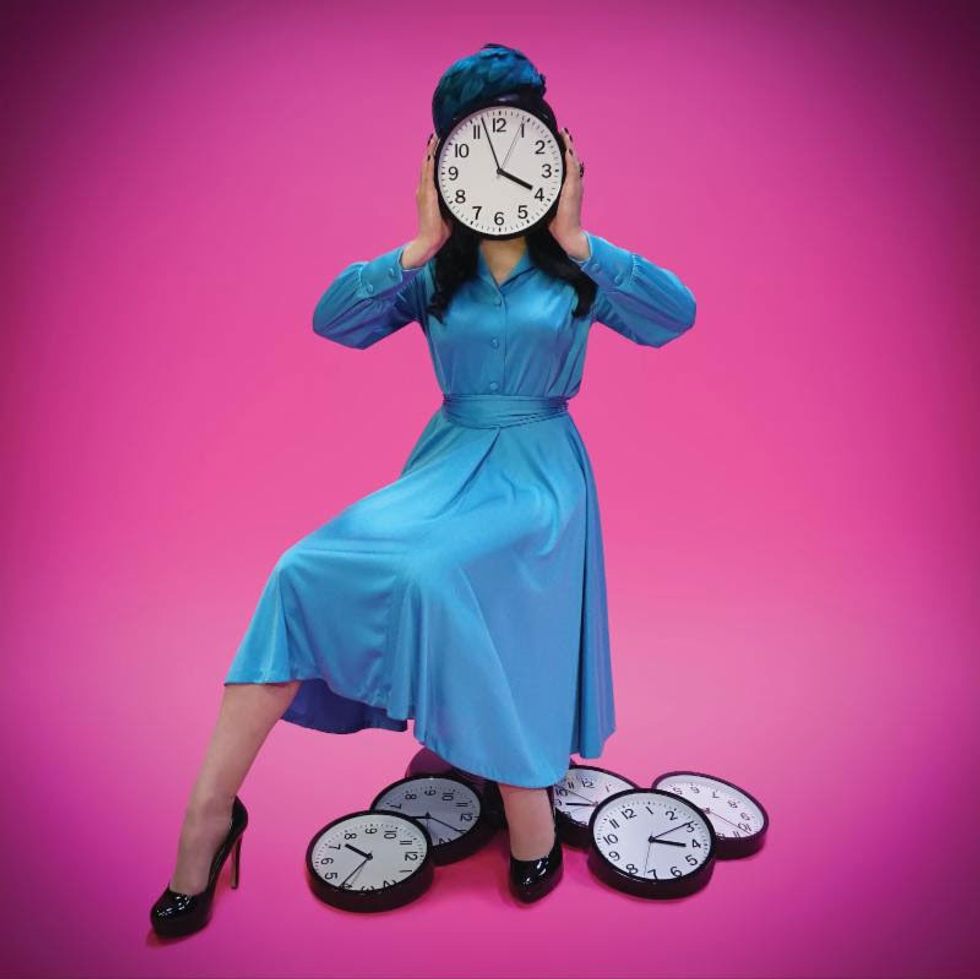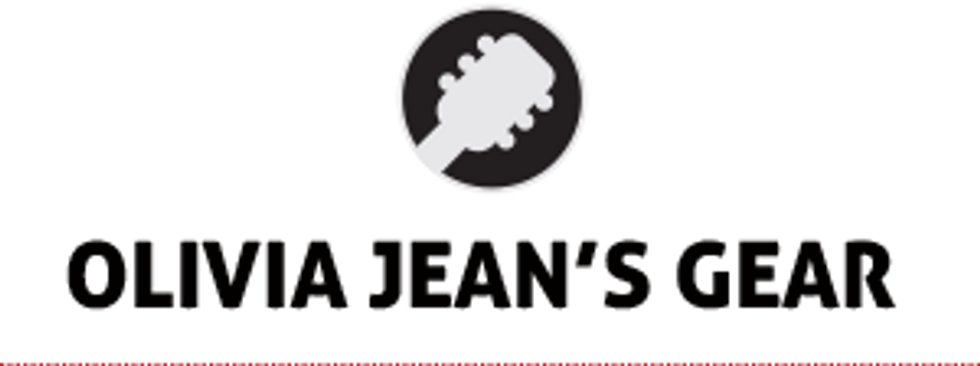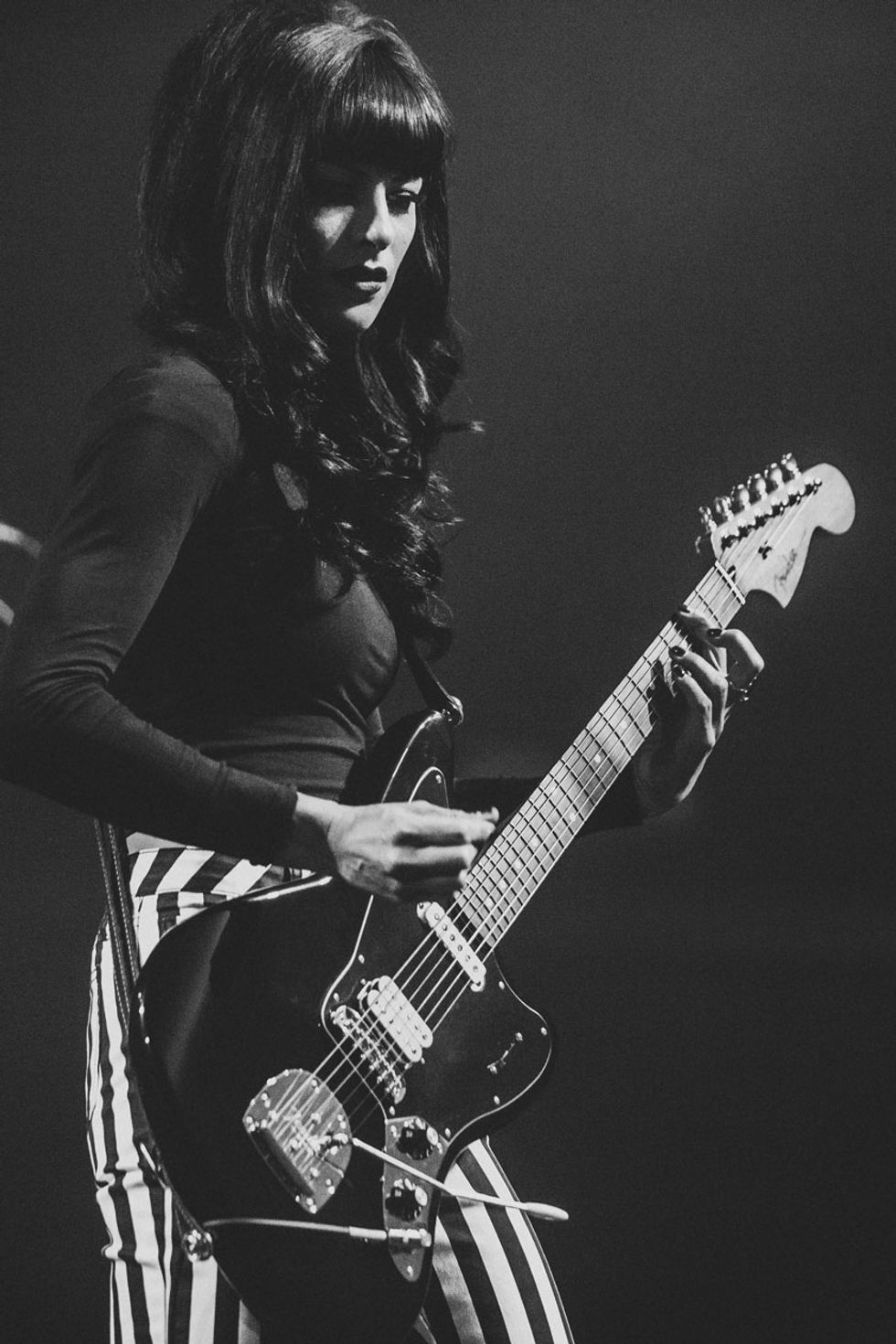Olivia Jean is addicted to Scopitone. Don’t judge. If your thing is ukuleles and miniskirts, you might get addicted to the short, ’60s-era Scopitone music videos, too. It was while binge-watching them on YouTube that she stumbled upon “Jaan Pehechaan Ho,” the Mohammed Rafi hit from the 1965 Bollywood suspense thriller, Gumnaam. That song became an obsession—she even made her band learn it—and she recorded it for her recent release, Night Owl.
“Isn’t it ridiculous?” Jean says about the song and its beyond-campy accompanying dance sequence. “It’s so cool. It’s also in that movie Ghost World, in the ending credits. That was my favorite thing to watch on YouTube and I learned it phonetically for fun. I asked the band I was playing with at the time, ‘Would you guys be willing to learn this song?’ And they said, ‘No.’ I said, ‘Pleeeeease?’ It’s extremely complicated. It’s more of an orchestral song, and if you listen to the original, the arrangement is all over the place. It’s very random. There’s a slight pattern, but not really, and that’s what makes it so difficult for the band to memorize.”
But ’60s kitsch isn’t Jean’s only addiction. In her early teens, she was hooked on instrumental surf music—or, more specifically, on recording instrumental surf music. She played every instrument and recorded to her laptop. “I would skip school,” she says. “My mom and dad were so angry at me for playing all day and night.” But her dedication paid off. She gave one of her home recordings to Jack White after a show, and he actually listened to it. He invited her to leave her hometown, Detroit, to join the team at Third Man Records in Nashville.
Jean started at Third Man as a session musician. She played bass with singer-songwriter Karen Elson, tic-tac bass with rockabilly legend Wanda Jackson, and worked as a multi-instrumentalist with numerous other artists. She toured and recorded with the goth-looking, garage-sounding Black Belles in 2012, and released her first solo album, Bathtub Love Killings, in 2014—again playing almost every instrument.
Night Owl is Jean’s second outing as a solo artist. She brought in other musicians to help speed up the recording process, but took the reins as producer. Songs like “Garage Bat,” “Siren Call,” and her cover of “Jaan Pehechaan Ho” have more of a twangy, surfy vibe than her last album, although the garage feel is still strong—especially on songs like the title track and “Perfume.” The numbers are short and the arrangements are tight, displaying her flair for economy. “I grew up listening to punk music,” she says. “A lot of the time I hear the melody in my head and I just need to get it out.”
We spoke with Jean about her experiences as a session player, the foundations of her guitar tone, the tracking and mixing of Night Owl, the mysteries lurking in Third Man’s bottomless gear closet, and the frustrations of being surrounded by so many expensive, unobtainable amps and guitars.
In the process of researching this article, I fell down a Wanda Jackson rabbit hole. What was your role in that band and what was it like working with her for 2011’s The Party Ain’t Over album and tour?
I was playing the tic-tac bass on a Fender Bass VI. Dominic Davis, the other bassist, was either playing standup or electric bass, and I would follow him with the tic-tac bass, to make it more prominent—me and Dominic were on a team.
You were playing in unison or were they interwoven parts?
Some songs we had interwoven parts. We had like 20 or 30 songs that we had to learn, so I can’t really name off the bat which ones we coordinated on—it was a long time ago, too—but we rehearsed the heck out of that set with that group of people. I was so starstruck that I didn’t even get a photo with her [laughs].
Is that Fender Bass VI yours? Do you use it on your albums as well?
No, that’s not my bass. I got to borrow that from Jack [White]. Before the Wanda Jackson tour, I’d never played one. I didn’t even know they existed. I never had a reason to look into it. I was really young when I went out on tour with Wanda Jackson. Growing up, I never had any mentors around me for vintage equipment or stuff like that, so working with Jack, that introduced me to a lot of stuff—vintage equipment, guitars. Before Third Man, I was like, “I’m happy with my $100 guitar, sounds cool.”
What vintage gear have you been turned onto since starting with Third Man?
I’m still getting schooled on vintage equipment. It’s hard when you can’t afford it to fall in love with it [laughs]. But Jack’s got a room full of amps—tons of vintage amps and they all sound great. I would say the one vintage piece of equipment that I want to steal is the Hofner bass. Maybe one day I can I afford one of those.It just sounds amazing. I had a rip-off Hofner bass when I was younger, but the actual thing is so easy to play.
Your basic guitar tone has just a touch of hair. Do you get your tone from your amp or are you more of a pedal person?
I use a Fender Hot Rod amp, which is great because it’s got drive on it and you can adjust that. I like giving it a little bit of drive and then, with my pedals, I adjust the dirt that I need. I always have my OCD pedal on, throughout the entire set. It gives you just enough dirt, but you can still hear the riffs. I don’t like using anything too distorted—especially because I have so many melodies going on in my songs, so many layers, that it really needs to poke through whenever I’m playing. I’ll use the OCD the entire set. For solos, right now I’m using the Westwood by EarthQuaker. I’m using the two drive pedals at the same time for solos. We play so damn loud onstage that I need to have easy access to those drive pedals or to my adjustments, because I will feed back like crazy if I don’t have it right in front of me. It’s mostly just my pedalboard that I control everything on. Otherwise I’ll have to run back to my amp.

TIDBIT: Olivia Jean’s new album, Night Owl, was recorded at Nashville’s Third Man Records studio. She produced, with assistance by engineers Joshua V. Smith and Logan Matheny.
So you’re constantly tweaking it?
I’m always tweaking it, because, unlike my recordings, those songs live translate really loud. Me and my guitarist are constantly battling over who gets to use more distortion or fuzz, or who’s louder.
But in the studio, you play all the guitars yourself?
For this album, I did bring musicians in to speed up the recording process, but I write everything. I write all the parts for all the instruments, let the musicians listen to it, and then mimic back exactly what I want them to play. Usually, I’ll do a demo for them.
And when you translate your songs for your live set, you’ve already dedicated the parts for the other musicians?
There’s a lot of coordination that has to go on with my songs. We usually have to strip them down because when I’m recording music, I don’t think, “Oh shoot, I won’t be able to have 20 guitar players onstage.” We translate the songs differently live. If I have a second guitarist on tour with me, I don’t want them to have to just play rhythm the whole time, because that’s boring. I’ll ask which solos they want to do and let them do a few solos and have fun onstage. And there are a few songs that I’m not able to play and do vocals at the same time—a lot of coordination has to go on, it’s like a puzzle.
Do you experiment with different gear in the studio or work with plug-ins to add variations to your sound?
A little of both. The good thing about recording at Third Man Studio is they have tons of equipment. I don’t need to bring anything, and usually Jack or the engineers know exactly what sound I’m going for. They’ll know exactly what amp or what mic to use. I’m really lucky to work with people like that who are so into gear. For my new record, I tried to mess around in post, too, but that’s actually something I don’t think I’m ever going to do again. Plug-ins are convenient and cool and they’re getting a lot better as time goes on, but it’s so much work if you don’t get it right when you record it, because it’s really hard to mimic the real thing. Especially with digital reverb, you can definitely hear the difference.
In addition to fronting her own band. Olivia Jean’s tenure at Third Man has included sessions and tours for other artists, playing guitar and bass. The most notable are Wanda Jackson and Karen Elson. Photo by David James Swanson
When you record every instrument yourself, every track is completely isolated, obviously. On this album, did you allow the instruments to bleed into other mics, or do you still try to keep that isolation?
I really prefer the live room sound with the whole band in the room. We did “Night Owl” that way, with live sound and bleed in the microphones. That’s my favorite song, production-wise, on the album. Doing things in isolation is necessary, but I prefer doing everything live as much as I can. You don’t have the freedom of saying, “Can I do that again?”—just stopping if you make one tiny little mistake. You feel like a jerk, stopping the entire band. You get things done faster, it’s more real sounding, and you can play off each other.
Do you have tricks for miking your amps?
Usually, we have the mic straight onto the amp for overdubs and such. If we’re doing live room sounds, we’ll have one of the amps isolated in a different room just to make sure that all the melodies are easy to hear. We mess around with isolating amps, especially for heavier songs.
When you play bass, do you approach it like a guitar and play it with a pick?
I play bass with a pick. I’m a guitar player and I tend to write bass lines like I do guitar riffs. They are very busy bass lines. Usually, my bass lines are so busy and fast that you need to use a pick—especially since I like the bass lines to poke through. I don’t like them to sound too muffled. I like the melodies to poke through.
You play drums, too.
When I first got into surf instrumental music, I started picking up all the instruments so I could record everything on my own. I became addicted to recording instrumental music.
What were you recording to?
When I was a teenager—and actually, the demo that I gave to Third Man, too—that was recorded through one of those long computer microphones that stand up like a stick. I was just recording through a free recording program. I think it was called Audacity. I would “mix” the songs in my car. I didn’t know what mixing was at that point and I didn’t know I was mixing. I didn’t grow up in a musical family and I didn’t grow up with any mentors for equipment, recording techniques, or whatnot. I just did it.
Where did you grow up?
I am from the suburbs of Detroit, but I would be in Detroit for everything music. The music scene was awesome. I lived on Nine Mile, so Detroit was just a couple of minutes away. It was easy to go to the city and see bands.
It didn’t matter that you were underage?
I never had a problem getting into a show. It was mostly local bands at bars. There were art-house shows that a lot of the musicians would have—not in venues—that I would go to when I was really young. I probably shouldn’t have been there at my age and I’m sure people were like, “Why is this child here?”

Guitars
Fender Player Series Jaguar
Fender American Professional Jazzmaster
Gretsch George Harrison Duo-Jet
1918 Gibson L-1 acoustic
Amps
Fender Hot Rod DeVille 2x12
Effects
Boss NS-2 Noise Suppressor
Electro-Harmonix Holy Grail
MXR Micro Amp
Fulltone OCD
EarthQuaker Devices Westwood
Korg Pitchblack Chromatic Tuner
T-Rex Fuel Tank power supply
Strings and Picks
Ernie Ball Regular Slinky (.010–.046)
Dunlop Nylon 1 mm
When you got to Third Man, was that your first experience doing sessions and playing other people’s music?
Yes, that was my first experience as a session musician. My first sessions would be the Wanda Jackson project. I was also the bassist for Karen Elson—that was another big one I did, touring-wise. It was really fun and I was excited to learn all those songs. I was excited to play other people’s music. I miss that a lot actually—playing other people’s stuff, instead of being in charge.It’s just less pressure, I guess.
How do you approach playing as a touring sideperson?
I try to play it exactly as they have it recorded, exactly as they want it. I take it very seriously, constantly playing those songs so I know them forwards and backwards. It’s still definitely a creative outlet, for sure, performing and such. I feel like you can live in the moment a little bit more when you don’t have that much on your shoulders as a frontperson.
Has that experience impacted how you write and record music?
I want to say no. I haven’t really changed much since I was a teenager, to be honest. But you definitely become a better musician when you do these sessions. You have to learn different techniques.
You sometimes play acoustic, but are you mainly an electric player?
Yes. Definitely. As the years have gone by, I realize that if you can’t play a song just with an acoustic guitar, then there’s a problem. I feel like writing on an acoustic guitar is something I should definitely start doing more, to get the backbone of the song done first.
What’s that acoustic you’re sometimes pictured with?
That acoustic is a Gibson L-1. It’s the famous one that Robert Johnson had. It is from 1917 or 1918. It’s a very special guitar and that’s my one acoustic guitar that I have. Only the best … [laughs].
Night Owl is your first outing as a producer. Did you work the board as well?
After the album, I feel like I can be an engineer for sure. I was there for the entire process. It was just me and the engineer in the room most of the time. I worked with two different engineers: Joshua V. Smith and Logan Matheny. There was a lot of one-on-one, just learning the board—learning the things that a musician doesn’t need to understand when you’re just being a musician. As a producer you have to take into consideration so many different things, and I learned a lot from those guys.Like EQ. It opened up my eyes to a whole new world.
When you record your songs, do they evolve from your original vision or is what we’re hearing basically what you had in your head at the outset?
What you hear on the recording is basically what I heard in my head when I first heard the music. My songs are very music driven. I’ll hear the riff in my head. I’ll do a full demo with drums, bass, and guitar. After I get the music down, which is what I hear first, then I’ll go and write lyrics. It is kind of backwards.
Are you one of these people who has a library of riffs in your phone?
I have in my voice memos tons of different guitar riffs that I hear in my head. There are really embarrassing ones, too. I’ll listen back and think, “What was I thinking?” I have a ton of song ideas, so that’s nice. I go through my riffs and listen for different things. Sometimes it works out where two riffs work together—where one is a guitar line and one is a bass line. With lyrics, I jot stuff down and I have a notebook full of ideas. I’ll go through that notebook, pick a topic, and see all these lines I’ve written thrown together, David Bowie-style, like picking them out of a fishbowl.
This solo performance from Third Man Records’ Blue Room venue in Nashville showcases Olivia Jean’s songwriting, vocal performance, and acoustic playing.







![Rig Rundown: Russian Circles’ Mike Sullivan [2025]](https://www.premierguitar.com/media-library/youtube.jpg?id=62303631&width=1245&height=700&quality=70&coordinates=0%2C0%2C0%2C0)






















![Rig Rundown: AFI [2025]](https://www.premierguitar.com/media-library/youtube.jpg?id=62064741&width=1245&height=700&quality=70&coordinates=0%2C0%2C0%2C0)




















 Zach loves his Sovtek Mig 60 head, which he plays through a cab he built himself at a pipe-organ shop in Denver. Every glue joint is lined with thin leather for maximum air tightness, and it’s stocked with Celestion G12M Greenback speakers.
Zach loves his Sovtek Mig 60 head, which he plays through a cab he built himself at a pipe-organ shop in Denver. Every glue joint is lined with thin leather for maximum air tightness, and it’s stocked with Celestion G12M Greenback speakers.











